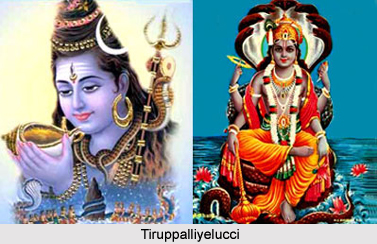 Tiruppalliyelucci is a form of poetic hymn which were similar to Tamil folk music as various poets during that period wrote poems inspired by folk music. There existed an ancient tradition in the Tamil nation for kings, ruler and noble leaders to wake up at early hours of morning to the strains of smooth music. Minstrels consistently sung the hymns after visiting the mansions and palaces of the noble personalities. This custom is still practiced in Tamil Nadu in specific months when people roam the streets singing various hymns at breaking dawn, but it is now practiced in modified form. In the Sangam age this poetic custom of waking noteworthy personalities in the early was called Tuyiletainilai. In the medieval age, particularly during the Bhakti Movement era, this poetic tradition came to be known as Tiruppalliyelucci.
Tiruppalliyelucci is a form of poetic hymn which were similar to Tamil folk music as various poets during that period wrote poems inspired by folk music. There existed an ancient tradition in the Tamil nation for kings, ruler and noble leaders to wake up at early hours of morning to the strains of smooth music. Minstrels consistently sung the hymns after visiting the mansions and palaces of the noble personalities. This custom is still practiced in Tamil Nadu in specific months when people roam the streets singing various hymns at breaking dawn, but it is now practiced in modified form. In the Sangam age this poetic custom of waking noteworthy personalities in the early was called Tuyiletainilai. In the medieval age, particularly during the Bhakti Movement era, this poetic tradition came to be known as Tiruppalliyelucci.
Tontaratippotiyalvar and Manickavasagar composed the Tiruppalliyelucci verses. Tontaratippotiyalvar was a Vaishnava saint poet whereas Manickavasagar was a Shaiva saint poet. Even in the present age, these poems are recited in a unique tune called Pupala Rakam, in shrines of both Lord Shiva and Lord Vishnu. The verses are composed in a specific metre and have been regarded as poetic works of immense merit by the following generations of scholars and poets like Citampara Cuvamikal and Tattuvarayar. Even the Paratamata Tiruppalliyelucci was composed by Paratiyar by utilizing the same meter, at the initiation of this century.
During the 18th century, Tattuvarayar, the well known Advaita philosopher, composed many works of Tiruppalliyelucci, other than composing Pallippattu and Tiruppavai based on the forms of Tamil folk songs. Some of the Tiruppalliyelucci works created by Tattuvarayar are Civappirakaca Cuvamikal Tiruppalliyelucci, Arul Tiruppalliyelucci, Tattuvappirakaca Nayanar Tiruppalliyelucci and Corupananta Cuvamikal Tiruppalliyelucci. These works are similar in content, rhythm and form to the other works composed by the hymnodists. Moreover, each of the Tiruppalliyelucci works contains 10 verses. The Tiruppalliyelucci song of Citampara Cuvamikal devoted to Lord Kartikeya (Mururgan) also comprises 10 verses and their rhythm and form take the traditional approach. Although the name of the shrine and the deity differ from between different tiruppalliyelucci poetic works, most other features remain the similar in all of them. Paratiyar composed the Paratamata Tiruppalliyelucci in the initial part of this century. The content of the verse deals with independence from slavery, patriotism and optimism.
Since the last 12 centuries, minimal changes in the form, lines and foot of Tirupalliyelucci verses have been witnessed. There is further evidence that even before the 8th century, Tirupalliyelucci type of versification had existed and contained similar forms and features. Further more, the content of the poetry like the approaching of the dawn, the rising sun, people waiting for their noble leaders to give instructions or receive favours and also the efforts of the minstrels to awake them from slumber, was almost similar as well. The climax of the poetic hymns with a plea to wake up also denotes the consistency which had existed over the centuries related to this specific form of poetry.



















